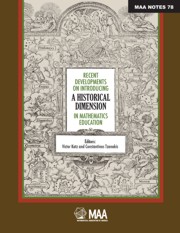Book contents
- Frontmatter
- Preface
- Contents
- 1 Teaching with Primary Historical Sources: Should it Go Mainstream? Can it?
- 2 Dialogismin Mathematical Writing: Historical, Philosophical and Pedagogical Issues
- 3 The Process of Mathematical Agreement: Examples from Mathematics History and an Experimental Sequence of Activities
- 4 Researching the History of Algebraic Ideas from an Educational Point of View
- 5 Equations and Imaginary Numbers: A Contribution from Renaissance Algebra
- 6 The Multiplicity of Viewpoints in Elementary Function Theory: Historical and Didactical Perspectives
- 7 From History to Research in Mathematics Education: Socio-Epistemological Elements for Trigonometric Functions
- 8 Harmonies in Nature: A Dialogue Between Mathematics and Physics
- 9 Exposure to Mathematics in the Making: Interweaving Math News Snapshots in the Teaching of High-School Mathematics
- 10 History, Figures and Narratives in Mathematics Teaching
- 11 Pedagogy, History, and Mathematics: Measure as a Theme
- 12 Students' Beliefs About the Evolution and Development of Mathematics
- 13 Changes in Student Understanding of Function Resulting from Studying Its History
- 14 Integrating the History of Mathematics into Activities Introducing Undergraduates to Concepts of Calculus
- 15 History in a Competence Based Mathematics Education: A Means for the Learning of Differential Equations
- 16 History of Statistics and Students' Difficulties in Comprehending Variance
- 17 Designing Student Projects for Teaching and Learning Discrete Mathematics and Computer Science via Primary Historical Sources
- 18 History of Mathematics for Primary School Teacher Education Or: Can You Do Something Even if You Can't Do Much?
- 19 Reflections and Revision: Evolving Conceptions of a Using History Course
- 20 Mapping Our Heritage to the Curriculum: Historical and Pedagogical Strategies for the Professional Development of Teachers
- 21 Teachers' Conceptions of History of Mathematics
- 22 The Evolution of a Community of Mathematical Researchers in North America: 1636–1950
- 23 The Transmission and Acquisition of Mathematics in Latin America, from Independence to the First Half of the Twentieth Century
- 24 In Search of Vanishing Subjects: The Astronomical Origins of Trigonometry
- About the Editors
24 - In Search of Vanishing Subjects: The Astronomical Origins of Trigonometry
- Frontmatter
- Preface
- Contents
- 1 Teaching with Primary Historical Sources: Should it Go Mainstream? Can it?
- 2 Dialogismin Mathematical Writing: Historical, Philosophical and Pedagogical Issues
- 3 The Process of Mathematical Agreement: Examples from Mathematics History and an Experimental Sequence of Activities
- 4 Researching the History of Algebraic Ideas from an Educational Point of View
- 5 Equations and Imaginary Numbers: A Contribution from Renaissance Algebra
- 6 The Multiplicity of Viewpoints in Elementary Function Theory: Historical and Didactical Perspectives
- 7 From History to Research in Mathematics Education: Socio-Epistemological Elements for Trigonometric Functions
- 8 Harmonies in Nature: A Dialogue Between Mathematics and Physics
- 9 Exposure to Mathematics in the Making: Interweaving Math News Snapshots in the Teaching of High-School Mathematics
- 10 History, Figures and Narratives in Mathematics Teaching
- 11 Pedagogy, History, and Mathematics: Measure as a Theme
- 12 Students' Beliefs About the Evolution and Development of Mathematics
- 13 Changes in Student Understanding of Function Resulting from Studying Its History
- 14 Integrating the History of Mathematics into Activities Introducing Undergraduates to Concepts of Calculus
- 15 History in a Competence Based Mathematics Education: A Means for the Learning of Differential Equations
- 16 History of Statistics and Students' Difficulties in Comprehending Variance
- 17 Designing Student Projects for Teaching and Learning Discrete Mathematics and Computer Science via Primary Historical Sources
- 18 History of Mathematics for Primary School Teacher Education Or: Can You Do Something Even if You Can't Do Much?
- 19 Reflections and Revision: Evolving Conceptions of a Using History Course
- 20 Mapping Our Heritage to the Curriculum: Historical and Pedagogical Strategies for the Professional Development of Teachers
- 21 Teachers' Conceptions of History of Mathematics
- 22 The Evolution of a Community of Mathematical Researchers in North America: 1636–1950
- 23 The Transmission and Acquisition of Mathematics in Latin America, from Independence to the First Half of the Twentieth Century
- 24 In Search of Vanishing Subjects: The Astronomical Origins of Trigonometry
- About the Editors
Summary
Introduction
As any high school math teacher will tell you, the word “trigonometry” means “triangle measurement.” The more perspicacious teacher might even know that the word was first coined by Bartholomew Pitiscus with his Trigonometriae [16], a study of the so-called “science of triangles” (Figure 24.1). This sounds familiar, even comfortable to modern teachers and researchers; we feel that we know what trigonometry is about, what it's for, and where it came from. For most of us, we couldn't be more wrong.
By 1600, much of the trigonometry that we saw in school had been known for well over amillennium. It had traveled through several major mathematical cultures, taking on different forms as it went. Trigonometry was not even properly a mathematical subject for most of this time, existing and taking its purpose mostly as a helpmate to astronomy. And this implies that what was really important to most trigonometric practitioners during its age of discovery—working with problems on the surface of the celestial sphere—is so marginal to us that (with a couple of minor exceptions) it has not been taught for several decades. How many of us today can state a single theorem in spherical trigonometry?
It is always a valuable experience to relive the mathematics of our past; this is especially true for trigonometry. Exploring the shadowy edges of a subject that recedes and eventually vanishes entirely into other disciplines and cultures as we move back in time reminds us of a couple of points that we are wont to forget.
- Type
- Chapter
- Information
- Publisher: Mathematical Association of AmericaPrint publication year: 2011



